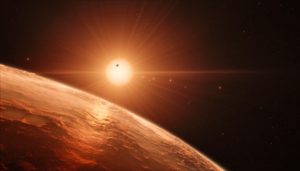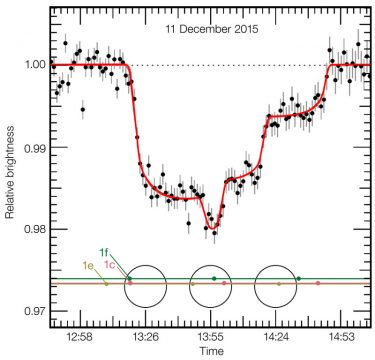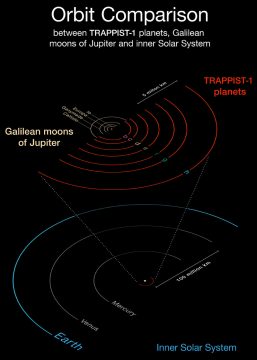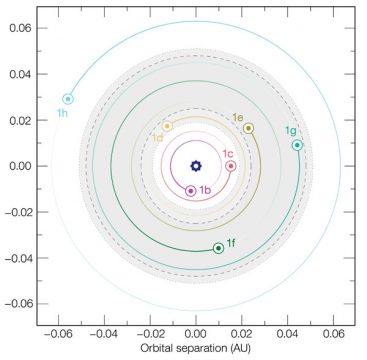Astronomers have found seven Earth-sized planets around a cool red dwarf, all of which have the potential for liquid surface water.

ESO / M. Kornmesser
The star TRAPPIST-1 is an unassuming, M8 red dwarf star. It lies 39 light-years away in the constellation Aquarius. With a diameter only one-tenth that of our star, the dwarf puts out less than a thousandth as much light as the Sun.
Last year, Michaël Gillon (University of Liège, Belgium) and colleagues announced that a trio of small exoplanets orbits this pipsqueak star (although the third world was of dubious reality). Now, after an intensive follow-up campaign, the team has discovered that there are actually seven planets, not three. All are likely rocky. Three lie in TRAPPIST-1’s putative habitable zone — the region where, given an Earth-like composition, liquid water could be stable on the surface. But all, with enough hand-waving, might have a chance at liquid water.
From Three to Seven

ESO / M. Gillon et al.
The astronomers detected the exoplanets using the transit technique, which catches the tiny dip in starlight when a planet passes in front of its host star from our perspective. The discovery roller-coaster began when the team found that what it had thought was a combined transit of planets #2 and #3 was in fact the crossing of three planets.
The observers next assailed TRAPPIST-1 with an impressive flurry of ground-based observations. But the big breakthrough came with the Spitzer Space Telescope, which observed the star for 20 days. These data caught 34 clear transits. The team was then able to combine their ground- and space-based observations and slice and dice them to determine that the signals likely came from seven different planets.
Only six of those are firm detections, however. Number 7, or planet h, is iffy in its specs: The team only detected a single transit for it, and astronomers prefer to see three transits before calling something a candidate planet. Expect astronomers to haggle over this one in months ahead.
Mini Solar System?

ESO / O. Furtak
Let’s assume for now that all seven exoplanets are real. All their orbits would easily fit inside Mercury’s circuit around the Sun. The years of the inner six range from 1.5 to 12 Earth days long, with the period of outermost h being anywhere between 14 to 35 days. The smallest two worlds are about three-fourths as wide as Earth, the largest 10% wider. The biggest orbit is less than 20% as large as Mercury’s.
One of the wonderful things about this system is that the exoplanets’ orbits are resonant with one another. This means that their orbital periods are rough integer multiples of one another — for example, in the same span of time that the innermost planet whips around the star eight times, the second planet takes five laps, the third three, and the fourth two. This setup gravitationally links the planets together and can lead to tiny shifts in their positions. Based on these shifts, the team could calculate the planets’ gravitational influences on one another, and hence their approximate masses and densities. All are consistent with being rocky, the team concludes in the February 23rd Nature.
Such resonant orbits arise when worlds migrate from their original locations, Gillon explains. Astronomers think that when lightweight planets form far out in a star’s planet-forming gaseous disk, gas drag and such will make them advance inward. During this inbound migration, the worlds catch one another in resonant orbits, such that they can form a kind of “chain of planets,” he says. In this case, the migration landed the exoplanets in what the team calls the “temperate zone” — orbits with enough incoming starlight that, with the right conditions, the planets might at least sometimes have liquid surface water. It’s a looser definition than that for “habitable zone.”
The planets are also all likely tidally locked with their star, meaning they always point the same hemisphere at it, as the Moon does to Earth. So close to the star, the planets could experience huge tidal pulls, stretching and squeezing their interiors and spurring heating and even volcanism, similar to what we see on Jupiter’s Galilean moons.
TRAPPIST-1 is quiet for an M dwarf — notably less active that Proxima Centauri, which also has a habitable-zone planet (although it’s likely a desert world). But unfortunately, astronomers don’t know how old the star is. It’s also unclear whether the planets’ orbits are stable: The researchers haven’t determined the seventh planet’s orbit, nor do they know if there are other worlds in the system mucking things up.
This kind of star, called an ultra-cool dwarf, is very common; roughly 15% of stars in the nearby galaxy fall into this category, Guillon estimates. Ultra-cool dwarfs live for trillions of years.
Are These Worlds Habitable?

ESO / M. Gillon et al.
The next goal is to look at the exoplanets’ atmospheres. If any of the worlds host life, then it might leave chemical fingerprints in the atmospheres. There’s no single compound that’s a smoking gun — for example, oxygen can come from life or from water molecules broken up by starlight into their constituent hydrogen and oxygen atoms. But certain combinations of chemical compounds (such as methane, carbon dioxide, and molecular oxygen) would be highly suggestive.
The team is developing a program to use the Hubble Space Telescope to look at the starlight passing through the planets’ (maybe extant) atmospheres as they transit, to detect any compounds that might have absorbed light. Follow-up will come with the James Webb Space Telescope, which will be more apt for this project because it focuses on infrared wavelengths, and TRAPPIST-1 puts out most of its light in infrared.
Study coauthor Amaury Triaud (Institute of Astronomy, UK) favors planet f as the most promising for life. With a girth of 1.05 Earths and about 60% Earth’s density, TRAPPIST-1f might be rich in water and/or ice. It receives about as much energy from its star as Mars does from the Sun, and with a good atmosphere it could be habitable. (Mars is technically in the Sun’s habitable zone.)
During a press conference Triaud painted this picture of what we might see, were we to stand on one of these worlds:
The amount of light reaching your eye would be something like 1/200 as much as you receive from the Sun on Earth — similar to what you experience at the end of sunset. However, it’d still be quite warm, because there’s still about the same amount of energy reaching you from the star as Earth receives from the Sun — it’s just that most of that comes in infrared, which you can’t see but your skin can feel. The star would be a salmon-like color. On TRAPPIST-1f, he estimated, the star would be three times wider in the sky than the Sun is to us.
“The spectacle would be beautiful,” he said.
Read more about the result in the European Southern Observatory’s press release.
References:
M. Gullon et al. “Seven temperate terrestrial planets around the nearby ultracool drwarf star TRAPPIST-1.” Nature. February 23, 2017.
Ignas Snellen. “Earth’s Seven Sisters.” (editorial) Nature. February 23, 2017.
Are you a fan of in-depth science journalism? Subscribe to Sky & Telescope.
 3
3









Comments
Frank-Schmidt
February 22, 2017 at 7:52 pm
Would like to know the star's coordinates and apparent magnitude. ..........Thanks
You must be logged in to post a comment.
Corey Rueckheim
February 22, 2017 at 9:21 pm
According to Wikipedia:
RA: 23h 06m 29.283s
DEC: –05° 02′ 28.59″
Apparent Mag: +18.80
You must be logged in to post a comment.
Dave
February 24, 2017 at 8:11 pm
There're some little black spots on that sun today...
You must be logged in to post a comment.
You must be logged in to post a comment.